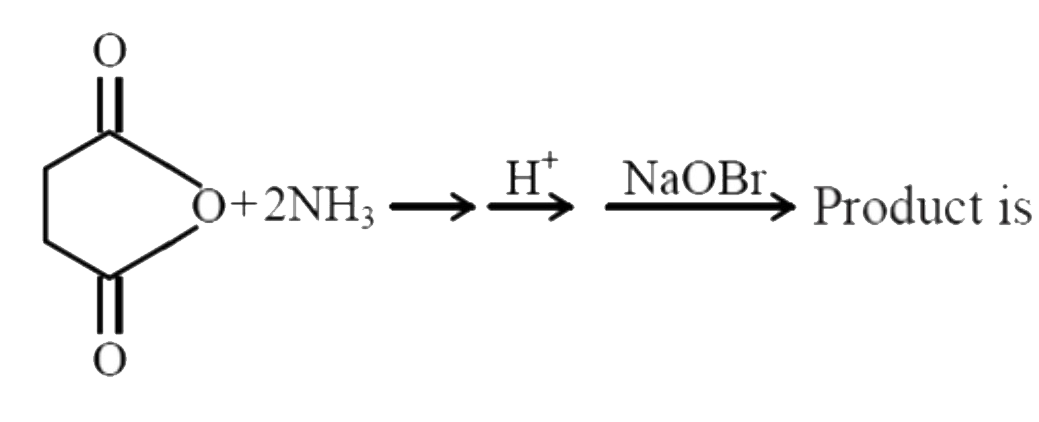Ph -CH = O + NH2−NH2H⊕−−→
(A).Product (A) is known as:
Aldo-Oxime
Hydrazone
Hydrate
Phenyl hydrazone
The correct Answer is:B
To solve the question regarding the reaction between benzaldehyde (Ph-CHO) and hydrazine (NH2-NH2) in the presence of an acid (H+), we can follow these steps:
1. Identify the Reactants:
- The reactants in this reaction are benzaldehyde (Ph-CHO) and hydrazine (NH2-NH2).
2. Understand the Reaction Type:
- This is a condensation reaction where a carbonyl compound (benzaldehyde) reacts with hydrazine. The reaction typically involves the formation of a hydrazone.
3. Reaction Mechanism:
- The carbonyl group (C=O) of benzaldehyde reacts with the hydrazine. The nitrogen atom of hydrazine attacks the carbon atom of the carbonyl group, leading to the formation of a tetrahedral intermediate.
4. Elimination of Water:
- In the next step, a molecule of water (H2O) is eliminated. This occurs when the oxygen from the carbonyl compound (benzaldehyde) loses a hydrogen atom and the nitrogen from hydrazine loses a hydrogen atom, resulting in the formation of a double bond between carbon and nitrogen.
5. Formation of the Product:
- The final product formed is phenylhydrazone, which has the structure Ph-CH=N-NH2. This compound is characterized by the presence of a double bond between the carbon and nitrogen.
6. Naming the Product:
- The product formed from the reaction of benzaldehyde and hydrazine is specifically known as phenylhydrazone.
Final Answer:
The product (A) is known as Phenylhydrazone.
- The reactants in this reaction are benzaldehyde (Ph-CHO) and hydrazine (NH2-NH2).
- This is a condensation reaction where a carbonyl compound (benzaldehyde) reacts with hydrazine. The reaction typically involves the formation of a hydrazone.
- The carbonyl group (C=O) of benzaldehyde reacts with the hydrazine. The nitrogen atom of hydrazine attacks the carbon atom of the carbonyl group, leading to the formation of a tetrahedral intermediate.
- In the next step, a molecule of water (H2O) is eliminated. This occurs when the oxygen from the carbonyl compound (benzaldehyde) loses a hydrogen atom and the nitrogen from hydrazine loses a hydrogen atom, resulting in the formation of a double bond between carbon and nitrogen.
- The final product formed is phenylhydrazone, which has the structure Ph-CH=N-NH2. This compound is characterized by the presence of a double bond between the carbon and nitrogen.
- The product formed from the reaction of benzaldehyde and hydrazine is specifically known as phenylhydrazone.
The product (A) is known as Phenylhydrazone.
Topper's Solved these Questions
- BOOK - MOTIONCHAPTER - CARBONL COMPOUNDSEXERCISE - EXERCISE -2 (LEVEL-II)18videos
CARBONL COMPOUNDS
- BOOK - MOTIONCHAPTER - CARBONL COMPOUNDSEXERCISE - EXERCISE - 310videos
CARBONL COMPOUNDS
- BOOK - MOTIONCHAPTER - CARBONL COMPOUNDSEXERCISE - EXERCISE -140videos
CARBONL COMPOUNDS
- BOOK - MOTIONCHAPTER - BIOMOLECULES & POLYMERSEXERCISE - EXERCISE - 4 (LEVEL II)17videos
BIOMOLECULES & POLYMERS
- BOOK - MOTIONCHAPTER - CARBOXYLIC ACIDEXERCISE - Exercise - 4 (LEVEL - 2 )22videos
CARBOXYLIC ACID
Similar Questions
Match list-l with list-ll and select the correct answer using the codes give below the lists:
List-l
(A) CH2=CH–CHONaBH4−−−−→
(B) C6H5CHO+Ph–NH2H⊕−−→
(C)C6H5COCH3+CH3–CH2–NH2H⊕−−→
(D) RCHO+2RCH2OHH⊕−−→
List-ll
(P) Acetal (Q) Schiff’s base (R) Unsaturated alcohol (S) EnamineView Solution
2NH_3 to overset(H^+)(rarr)overset(NaOBr) product is:View Solution
Knowledge Check
- Question 1 - Select One
R−NH2+CH3COCl(excess)−−−−→A.
The product (A) will be -ARNHCOCH3BRN(COCH3)2CR+N(COCH3)3Cl−DR−CONH3 - Question 2 - Select One
Ph−O∣∣C−NH2POCl3−−−→(A), Product (A) is
APh−NH2BPh−CH2−NH2CPh−OH∣CH−NH2DPh−C≡N - Question 3 - Select One
Ph−O∣∣C−O−CPh318H3O⊕−−−→ Product of this reaction is :
APh−O∣∣C−OH+Ph3C−18OHBPh−18O∣∣C−OH+Ph3C−OHCPh−O∣∣C−18OH+Ph3C−18OHDPh−O∣∣C−18OH+Ph3C−OH
HO-CH2−CH2-CH =O (1)KCN−−−−−−−→(2)H⊕(3)H2O⊕(4)Δ(A), Product (A) is ,
View SolutionCH3−CH2−O−C∣CH3=CH2H3O⊕−−−→Products are
View SolutionPh−OH∣CH−CH3PCC−−→(A)NH2−NH−O∣∣C−NH2−−−−−−−−−−−−−→(B)
Product (B) is :View SolutionEtCOOMe(A)(i)NH2NH2(ii)HNO2−−−−−−−−−−−−→(iii)ӨOH(iv)H3O⊕(B)
The product (B) is :View Solution_S01_838_Q01.png) +CH3NH2→ Product: product is :View Solution
+CH3NH2→ Product: product is :View Solution

